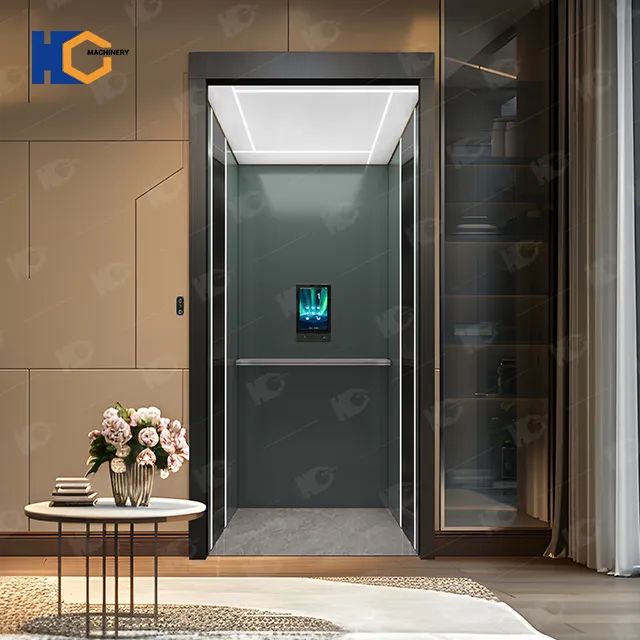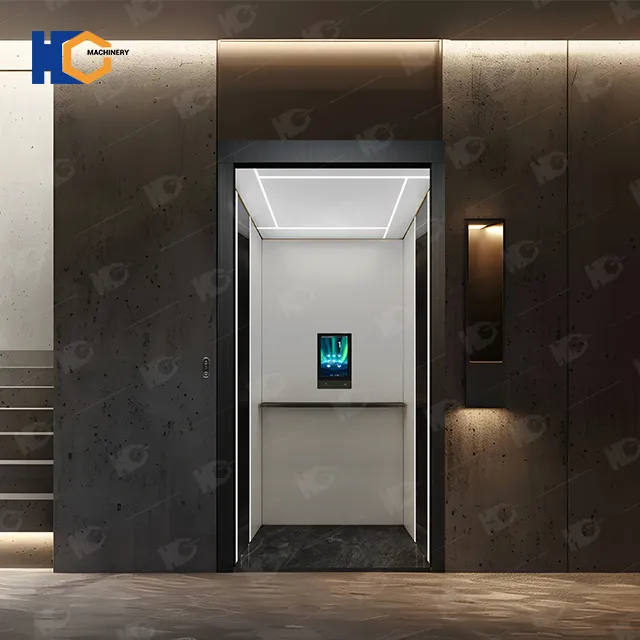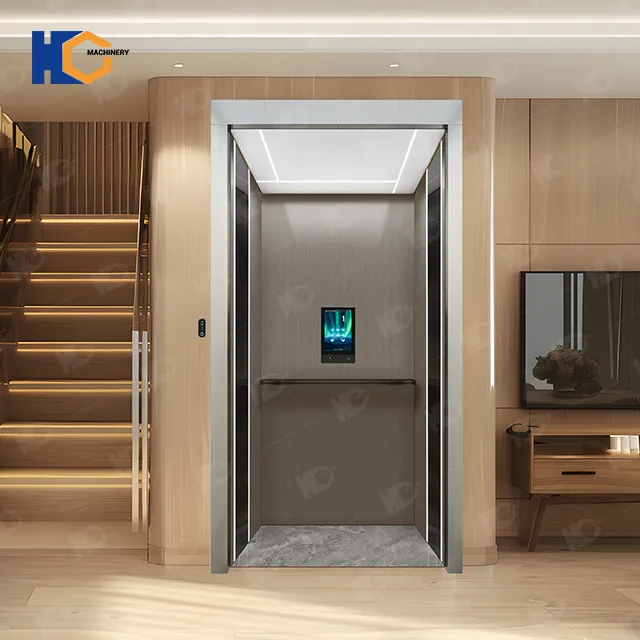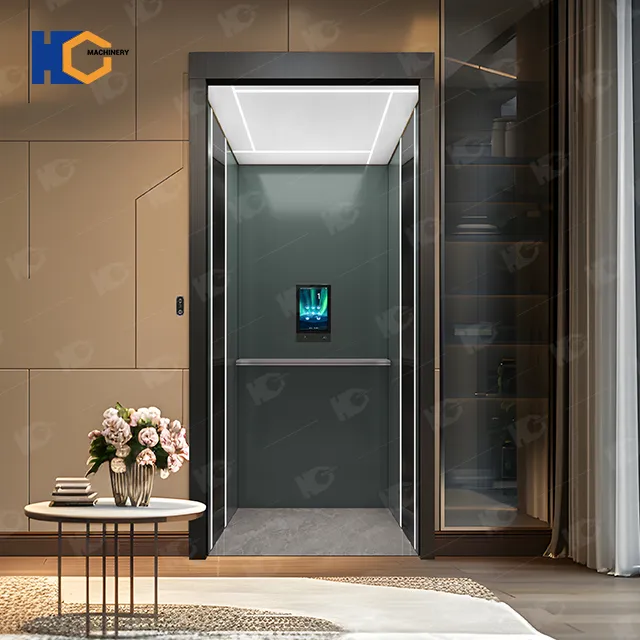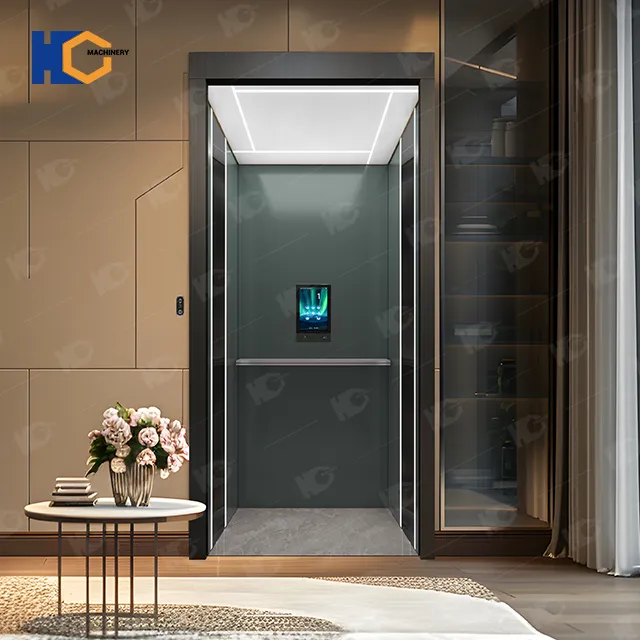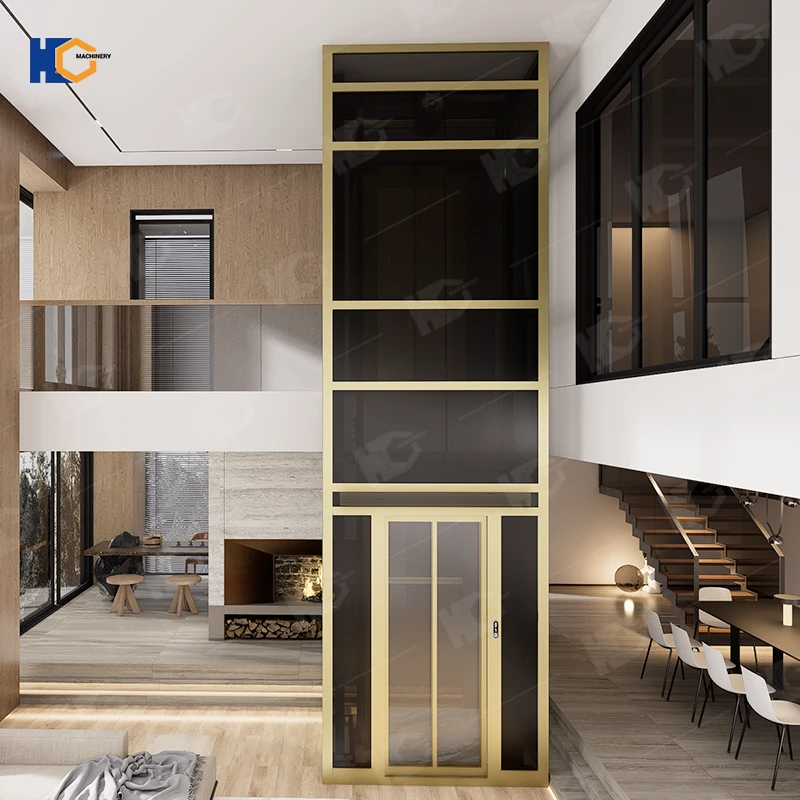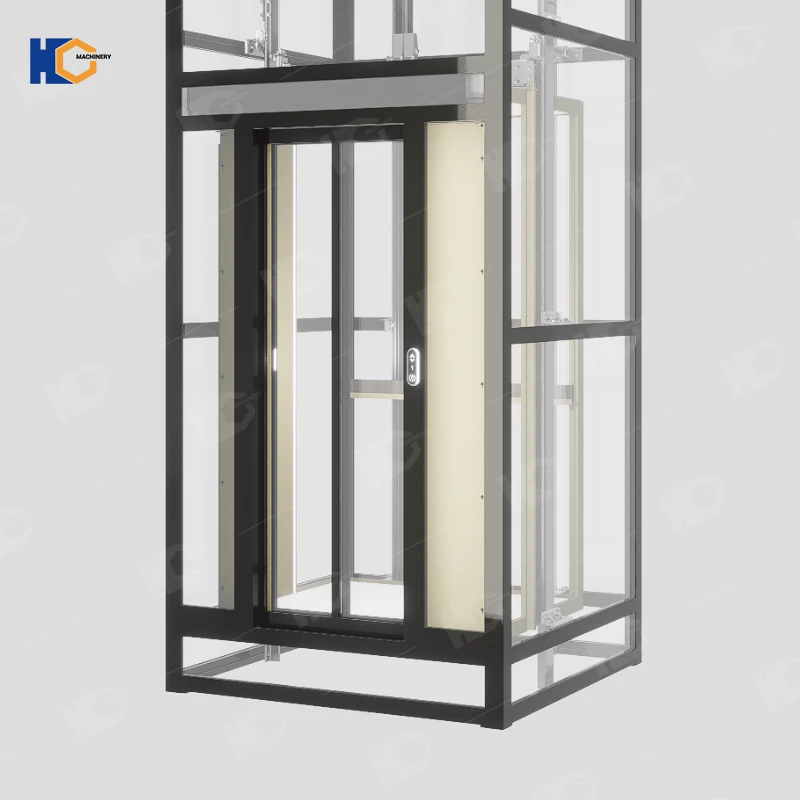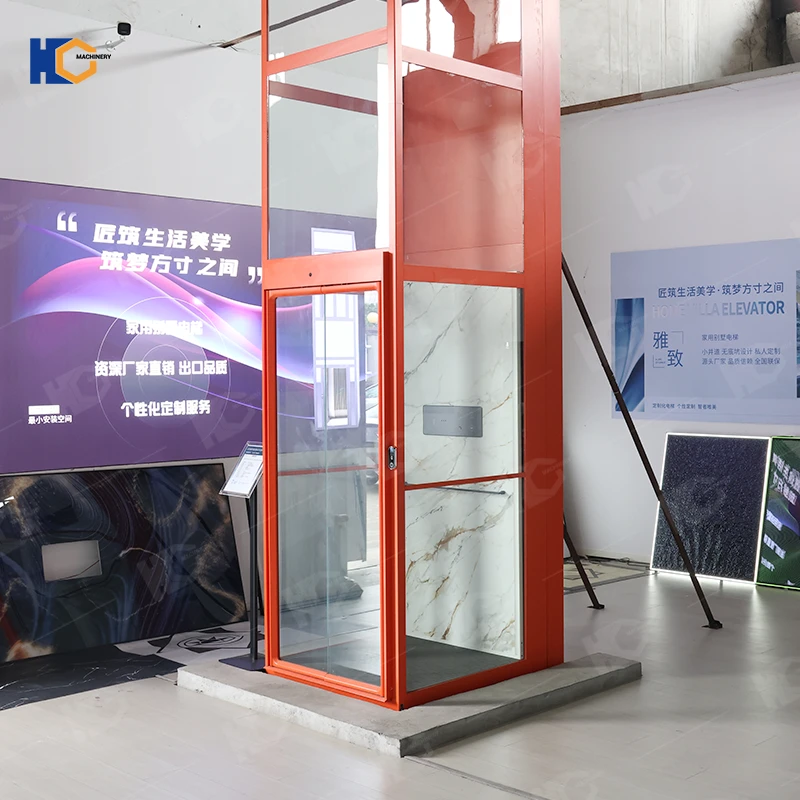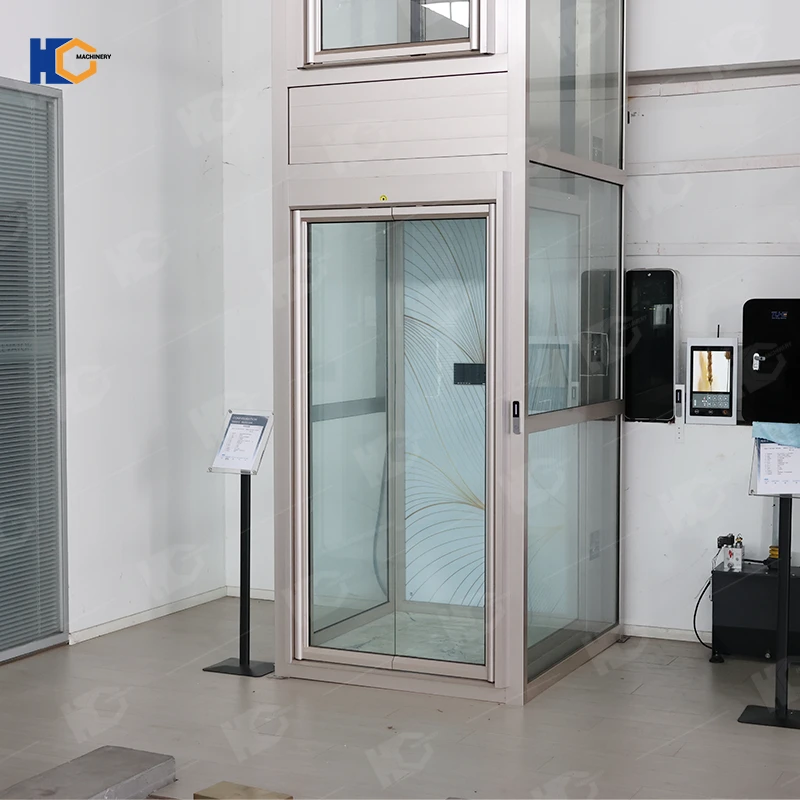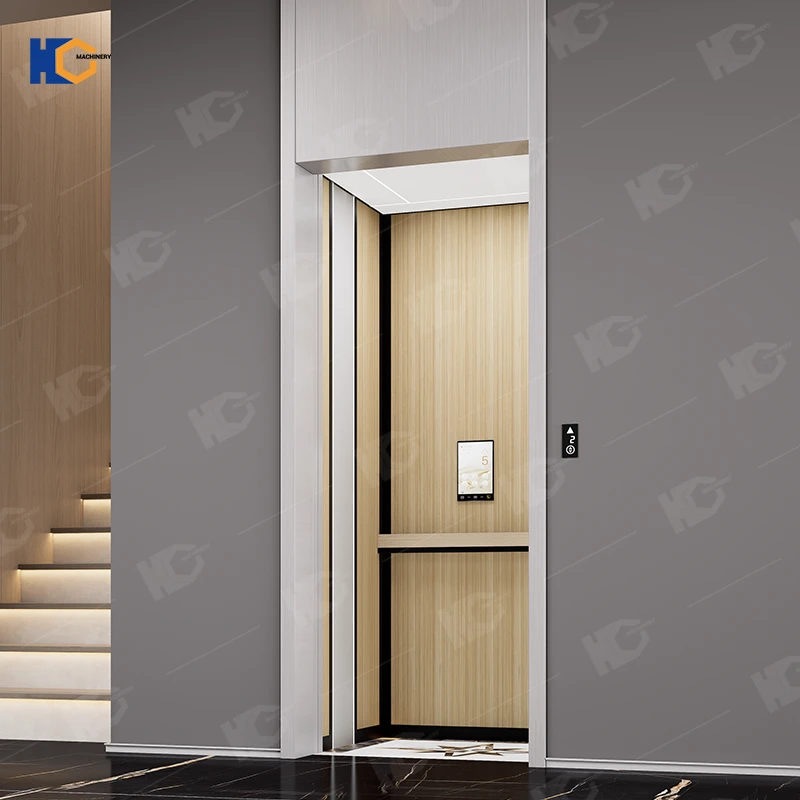What is hydraulic elevator?
A hydraulic elevator is an elevator driven by a hydraulic system. It uses a pump station to push hydraulic oil into the hydraulic cylinder, which then moves the elevator car up and down. Hydraulic elevators are currently the most popular and most popular home and villa elevators on the market.
Hydraulic elevators are usually used as home elevators for 2-4 floors, and we recommend that the maximum lifting height should not exceed 12 meters. The working principle of hydraulic elevators is to achieve lifting and lowering operation through a hydraulic system. Hydraulic elevators include hydraulic cylinders, hydraulic pump stations and control systems. The hydraulic pump draws hydraulic oil from the oil tank and presses it into the hydraulic cylinder, and the piston in the hydraulic cylinder moves accordingly, thereby pushing the elevator up and down. The hydraulic valve controls the flow direction of the hydraulic oil, allowing the elevator to rise or fall when needed. The control system monitors and adjusts the operation of the elevator to ensure its safety and stability. The entire system is powered by hydraulic pressure, allowing the elevator to run smoothly.
157122.webp)
hydraulic elevator is an elevator driven by a hydraulic system
What are the characteristics and advantages of hydraulic elevators?
Compared with other types of elevators, hydraulic elevators have the following characteristics and advantages:
Simple structure: The structure of hydraulic elevators is relatively simple, consisting of hydraulic cylinders, hydraulic pumps and control systems, and is relatively easy to maintain and repair.
Easy installation: Hydraulic elevators do not require deep pits, and for outdoor shafts, concrete or steel structure shafts can be built by themselves, so the installation is relatively simple and suitable for places with low building heights.
Smooth operation: Hydraulic elevators run smoothly, the lifting speed is relatively stable, and the ride is comfortable.
Energy saving and environmental protection: Hydraulic elevators only consume a small amount of hydraulic oil during operation, which can save energy compared to traditional elevators.
Low cost: The manufacturing cost of hydraulic elevators is relatively low, and the maintenance cost is also relatively low, which is suitable for some places with limited budgets.
In general, hydraulic elevators have the advantages of simple structure, easy installation, smooth operation, energy saving and environmental protection, and low cost, which are suitable for some low-rise buildings or places that need to be economical.
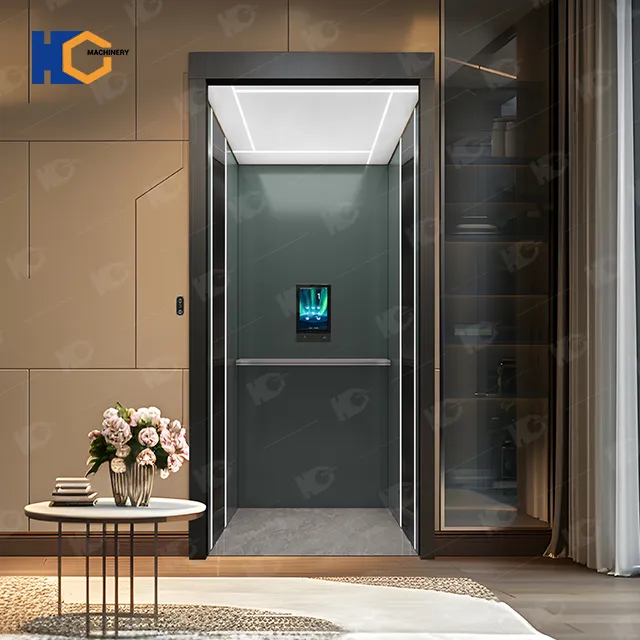
Working Principle of a Hydraulic Elevator System
The hydraulic elevator operates based on Pascal’s Law, which states that pressure applied to a confined fluid is transmitted equally in all directions.
Here’s how it works step by step:
Step 1: Lifting the Elevator (Upward Movement)
A motor-driven pump pushes hydraulic oil from the reservoir tank into the cylinder.
As oil fills the cylinder, it pushes the piston upward, which in turn raises the elevator car.
When the car reaches the selected floor, sensors signal the control valve to stop the pump.
Step 2: Lowering the Elevator (Downward Movement)
To move down, the control valve slowly releases hydraulic oil back to the reservoir.
The piston retracts under the car’s weight, allowing a smooth and controlled descent.
Flow speed and direction are managed by precision valves to ensure passenger safety.
Step 3: Emergency or Power Failure
In case of a power outage, the elevator can automatically descend to the lowest floor using stored hydraulic pressure or a manual lowering valve.
3. Main Components of a Hydraulic Elevator System
A hydraulic elevator consists of several key mechanical and electrical components. Each plays a critical role in ensuring performance, safety, and reliability.
| Component | Function |
|---|---|
| 1. Pump Unit | Generates pressure to move hydraulic oil into the cylinder. Usually powered by an electric motor. |
| 2. Hydraulic Cylinder | The chamber that holds the piston and hydraulic fluid for vertical motion. |
| 3. Piston (Ram) | Moves up and down inside the cylinder to lift or lower the elevator car. |
| 4. Oil Tank (Reservoir) | Stores hydraulic oil used by the pump system. |
| 5. Control Valve | Regulates oil flow and pressure to ensure smooth motion. |
| 6. Elevator Car (Cabin) | The compartment where passengers or cargo are carried. |
| 7. Guide Rails | Keep the elevator car moving straight and stable. |
| 8. Controller (PLC or Microprocessor) | Receives signals, operates the pump, and manages safety functions. |
| 9. Safety Devices | Include emergency stop, overload protection, and door interlocks. |
Types of Hydraulic Elevator Systems
Hydraulic elevators come in different configurations depending on shaft space, travel height, and installation conditions.
4.1 Conventional Hydraulic Elevator
Uses an underground cylinder directly beneath the shaft.
Suitable for new buildings with pit space.
Travel height: up to 5–6 floors.
4.2 Holeless Hydraulic Elevator
Uses side-mounted pistons — no need for an underground hole.
Ideal for renovations or existing buildings.
Travel height: 2–5 floors.
4.3 Roped Hydraulic Elevator
Combines hydraulic power with steel ropes and a pulley system.
Allows greater travel distance (up to 20 meters or 6–7 floors).
Common in commercial and residential mid-rise buildings.
What are the shortcomings of hydraulic elevators and how to solve them?
Disadvantages:
1. The common hydraulic elevators on the market use ordinary steel structures, which are very prone to rust and corrosion after a long time of use, which greatly affects the daily use of the elevator.
2. Most manufacturers of hydraulic elevators use guide wheels for rail operation, and the guide wheels will be damaged after a long time of use, which also greatly affects the use of hydraulic elevators.
3. There may be noise when the hydraulic elevator rises.
4. During the installation process, the hydraulic elevator may have wiring errors and cannot match the distribution box.
Solution:
1. The overall structure of our elevator uses a hot-dip galvanized structure, which is much more corrosion-resistant and rust-proof than ordinary steel.
2. Our hydraulic elevator uses guide shoes, which do not require any lubricant to assist in movement. There are two oil pots on our guide rails to assist.
3. Our hydraulic elevator uses the latest ultra-quiet pump station with almost no noise.
4. Our distribution box is independently developed by us. We connect all the wires in the distribution box in advance and clearly mark each wire. After the customer receives the equipment, he only needs to install it according to our markings.
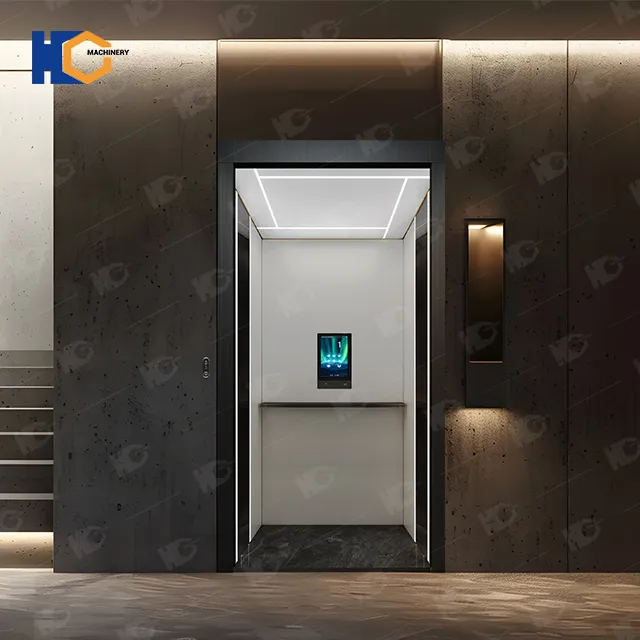
What are the advantages of Huichuang Lift's hydraulic elevators compared to other factories?
1. Hot galvanized structure, which is more anti rust than painting.
2. Governor and tensionor, same as passenger elevator, which can make the cabin stop immediately if the speed is over 0.4m/s.
3. 1:3 design, it means when the cylinder move 1m, the cabin will move 3m, travel speed can reach 0.3m/s, which is faster than 1:2.
4. We have our own team to develop and manufacture control box, this is the heart of lift, ours no need to connect too many wires, only some plug to fill in, very simple and clean.
5. Kone U61 leveling device, which is more smoothly than mechanic limit switch.
6. Nylon guide wheel, which is more durable and silence than steel wheel. Wheels covered by steel plates, apart from damage.
7. Wire rope, which is more stable and silence than chain.
8. Oil return tube, as a backup tube for hydraulic oil if the main tube breaks, and it can make the air out of the oil cylinder.
9. T78 passenger elevator rail, more durable than T75.
10. Our shaft adopt 50*50*2.2mm aluminum alloy material, and multiple color options.
11. All structure bolts connected, no need welding.
12. Multiple COP&LOP options, can customize your logo or picture.
13. Standard cabin fan, bottom safety sensor, handrail,light curtain.
The elevator hydraulic system price range is between 4000USD to 10000USD,in order to get a accurate price for your elevator.If you would like to learn more about the pricing of the hydraulic elevator system, please click here.
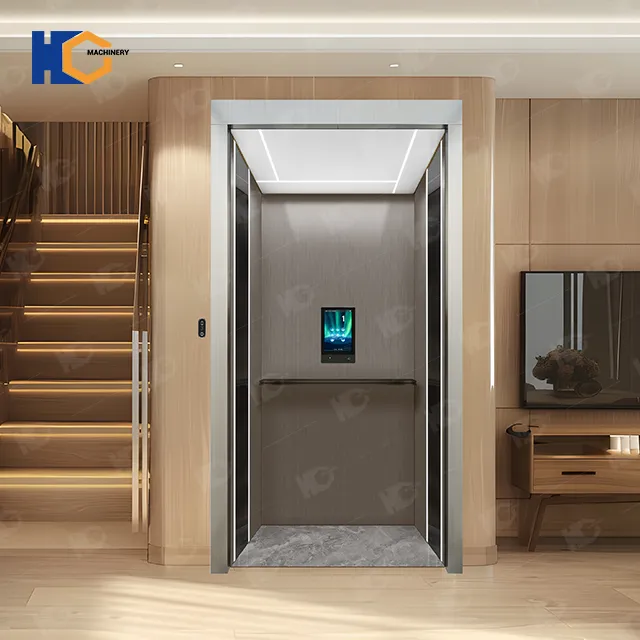
How to choose an elevator that is more suitable for us?
The hydraulic elevator system is a proven, safe, and cost-effective vertical transportation solution.
It’s ideal for low-rise buildings, homes, commercial spaces, and factories, offering:
Smooth and quiet ride experience
Easy installation with no overhead room
High lifting capacity and safety
Flexible customization options
If you are looking for an affordable and reliable elevator solution, a hydraulic elevator system is one of the best choices for your building in 2025 and beyond.
Please contact our technicians. Our technicians will customize the elevator for you based on the actual situation of your site: the number of floors, floor height, installation space, whether shafts are needed, and other customized requirements, and customize the drawings for your elevator for your reference.
FAQ
1. How does a hydraulic elevator work?
A hydraulic elevator operates by using an electric oil pump to pressurize hydraulic fluid into a cylinder, which pushes a piston upward to lift the car. During descent, the fluid flows back to the reservoir through a valve, and the car descends by gravity. Core components include the hydraulic pump, cylinder, control valve, and reservoir.
2. Are hydraulic elevators safe?
Yes, hydraulic elevators are designed with multiple safety mechanisms:
Mechanical anti-fall devices: Speed-limiting cutoff valves prevent uncontrolled descent if the oil pipe ruptures.
Redundant valves: Multiple control valves ensure stable system pressure.
Emergency braking: Backup power or manual oil pressure release is activated during power outages.
3. Are maintenance costs for hydraulic elevators high?
Maintenance costs are generally higher than for traction elevators due to issues like oil replacement and aging of cylinder seals. Regular inspections are recommended:
Oil level and quality (quarterly)
Filter cleanliness
Wear and tear of valves and pumps
4. What is the energy consumption of hydraulic elevators?
Energy consumption is relatively high, especially during frequent starts/stops, as the pump must continuously work to maintain pressure. Energy-saving solutions include:
Variable displacement pumps (adjust flow on demand)
Regenerative systems to recover potential energy during descent (available in high-end models)
5. What are the installation requirements for hydraulic elevators?
Rise height: Typically limited to 12 meters (≈4 floors), extendable up to 20 meters with multi-stage cylinders.
Machine room: No need for a machine room (ideal for low-rise buildings).
Hoistway space: Requires space for cylinder installation (usually behind or beside the car).
6. How noisy are hydraulic elevators?
Noise levels are relatively low (around 50–60 decibels), quieter than traction elevators due to no wire rope friction. Brief noise may occur during pump startup.
7. What are the speed and load capacity of hydraulic elevators?
Speed: Typically 0.15–0.5 m/s, suitable for low-speed applications.
Load capacity: Commonly 1–3 tons, with custom designs up to 5 tons (requiring larger-diameter cylinders).
8. Do hydraulic elevators impact the environment?
Potential risks:
Oil leakage: May contaminate soil; use environmentally friendly hydraulic oil and conduct regular seal integrity checks.
Energy inefficiency: Higher long-term carbon emissions compared to traction elevators.
9. What is the lifespan of a hydraulic elevator?
Average lifespan: 15–25 years, depending on maintenance. Key components (e.g., cylinders, pumps) last 10–15 years and require periodic replacement.
10. How do hydraulic elevators differ from traction elevators?
| Comparison | Hydraulic Elevator | Traction Elevator |
|---|---|---|
| Drive principle | Hydraulic force | Wire ropes + traction sheave friction |
| Machine room | Typically none | Required (top or separate) |
| Maximum rise | Limited (≤20m) | Up to 100+ meters |
| Energy use | Higher | Lower (especially high-speed models) |
| Applications | Low-rise buildings, villas, no-machine-room needs | High-rises, commercial complexes |
Summary: Hydraulic elevators are ideal for low-rise, low-frequency use due to their simple design and minimal hoistway requirements. However, trade-offs in energy consumption and maintenance costs should be considered. Selection should align with building needs and budget constraints.
